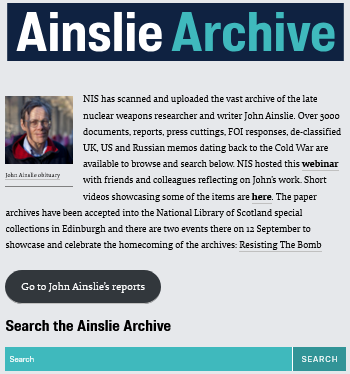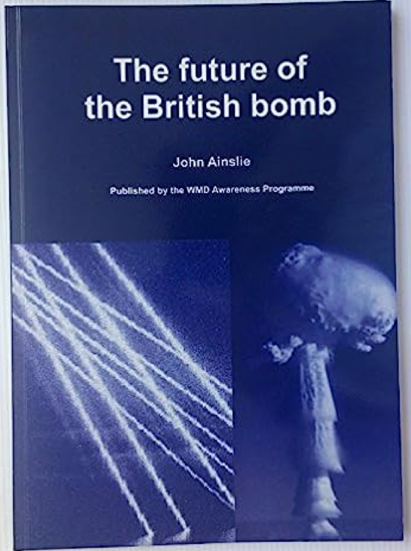Who was John Ainslie?

John Ainslie was the coordinator of the Scottish Campaign for Nuclear Disarmament (CND) from 1992 until his death in 2016. The Guardian’s obituary stated that he was ‘the quiet, unassuming heart of the peace movement in Scotland for the last 25 years’. As well as taking part in campaigning and direct action in support of disarmament, he was ‘an authoritative and internationally respected nuclear researcher’. John authored twenty reports on nuclear policy, starting in 1992 with Cracking Under Pressure, about defects in British nuclear submarine reactors.
The main subjects of John’s reports include: how Britain relies on the US to maintain its nuclear status; the practicalities of British nuclear disarmament and Scotland’s contribution to it; the costs and risks of the UK’s nuclear weapons modernisation programme; technical problems with the UK’s nuclear-powered submarines; the UK’s targeting of Russia with nuclear weapons during and after the Cold War; and the humanitarian consequences of the use of nuclear weapons by the UK. This article will explore some of the key issues John worked on, and how they feature in his archive.
- What is the Ainslie Archive?

The contents of the Ainslie Archive reflect the many different research interests John had, and the complexities involved in studying nuclear weapons and disarmament. The archive consists of thousands of documents, primarily relating to the UK’s nuclear weapons programme, that John collected over several decades. Information in his archive was gathered from a wide range of sources, including official US and UK files, correspondence with activists and government, civil society reports, photos, graphs, newsletters, and media articles. NIS has been working since late 2021 on digitising the documents in the archive so that they are freely accessible. So far, over 3,500 items have been uploaded to the dedicated online library.
The Ainslie Archive provides insights into John’s approach to the varied nuclear issues he worked on, including what he viewed as worthy of investigation and needing public debate. These include: UK preparations in the 1980s for Civil Defence in the event of a nuclear attack; how British strategists developed plans to target Russia with nuclear weapons, including the famed Moscow Criterion; and the purpose of the many nuclear weapons-related sites in the UK—both British and American. NIS hopes that providing a platform for John’s work will allow researchers to better understand nuclear history and decision-making. We believe it is vital to both prevent the nuclear past—and all its dangers—from being forgotten, and to understand how and why nuclear risks persist today.
- Nuclear disarmament: activism and protest

John was a tireless researcher and committed activist, taking part in and speaking at protests up and down Scotland, and beyond. The archive is a treasure trove of documents detailing the UK peace and disarmament movement’s activities, including pamphlets, petitions, research reports and news stories. The work of numerous campaigning and research groups are featured in the archive, including Greenpeace, Pugwash, the Women’s International League for Peace and Freedom, Abolition 2000, Trident Ploughshares, and Faslane Peace Camp—to name but a few—showing John’s knowledge of civil society and his connection with many different people.
CND was founded in 1957 and Scottish CND in 1958, growing in strength as and when the threat of nuclear conflict and tensions between East and West peaked. By the time that John became coordinator of Scottish CND in the early 1990s, the movement was in a transitional phase after the end of the Cold War, and the perception that the nuclear threat had faded. The movement in Scotland retained its vibrancy largely because of the presence of Trident submarines in its waters. Scottish CND activists thus observed that public support for disarmament in Scotland was stronger than in England, giving the group an especially important role in achieving a nuclear weapons free future.
In 2012, John wrote an important report on the technical aspects of disarmament entitled Disarming Trident. The report considers what a newly independent Scottish government could do to rid itself of the UK’s nuclear weapons, explaining that, ‘Holyrood could establish a timetable for the de-activation of Trident, within days and weeks, followed by the removal of all nuclear warheads from Scotland within two years’. The archive contains many of the primary and secondary research documents which formed the basis of this and the many other reports John produced.
In addition to direct action and protests at nuclear bases and sites, the day-to-day business of campaigning required letter-writing and submitting Freedom of Information Act requests to public bodies, as well as mounting legal challenges to the actions of the British government. The archive therefore contains correspondence from Ainslie (and other campaigners) to lawyers, MPs, Peers, MEPs, local councillors, and other officials. These campaigning efforts focus on issues including: the safety of, and incidents involving, Royal Navy submarines; exposure of workers and Naval personnel to radiation; military exercises involving nuclear weapons; emergency government exercises for nuclear accidents; and building support for a Nuclear Weapons Convention.
- What does it mean for the UK to be a nuclear weapon state?
As noted above, John’s work focused on the goal of how to eliminate the UK’s nuclear weapons. To strengthen his arguments for why the UK should not possess the bomb, John spent much of his time studying the UK’s various nuclear projects. John sought to understand the history of the British bomb, and official justifications for it, to expose the truth about the real costs and risks of nuclear possession for the UK. The archive therefore contains a great deal of data covering the evolution of the UK’s nuclear arsenal. This mainly involves the Polaris and Trident nuclear weapon systems, beginning in the 1960s and continuing through to the 2010s.
Since the late 1950s, UK decision makers have been concerned about the credibility of the British nuclear weapons system. The size and shape of the UK’s nuclear arsenal has thus continually evolved, being shaped by a range of domestic and international political and military factors. These factors include: the cost of nuclear possession given the UK’s limited resources; the level of domestic political support for the bomb; the scope and availability of US technological support; assessments of Russia’s military capabilities; the role of UK nuclear weapons in European and NATO security; and the UK’s identity as a leading world power.
The files John acquired through Freedom of Information Act requests and research at the National Archive shed light on high-level internal debates concerning Britain’s need to possess a nuclear deterrent. Decision-makers discussed what shape the UK’s nuclear force should take, what level of deterrence was required, and how many Soviet cities needed to be destroyed for the UK to pose a credible threat, based on calculations of what ‘unacceptable damage’ would be for Russia. As a Guardian article in 2010 outlined, the UK’s nuclear war plan for Trident during the Cold War would have killed up to 10 million Russian people, if implemented.
The decision to adopt the Trident missile system was officially taken by the UK in 1982, and Trident came into service in 1994. The UK continually presented its nuclear arsenal as a ‘minimum deterrent’, but, as Greenpeace noted in 1992, Trident was a substantial upgrade on Polaris, both in terms of warhead capacity, yield, accuracy and range. The acquisition of the successor to Trident—comprising four new nuclear armed submarines named Dreadnought—was approved in a series of parliamentary votes between 2006 and 2016. The archive includes a number of updates, other analysis and notes that John produced about Trident replacement.
Despite the end of the Cold War, the debates and concerns highlighted in these files continue to be relevant today. NIS has reviewed in recent publications the rising costs and risks involved in the UK’s multi-decade, multi-billion-pound nuclear rearmament programme. We shall likely have to wait many years for the internal debates surrounding this programme to be released. If and when these official files see the light of day, it is likely that many of the issues discussed will sound familiar. As was reported by Construction Week back in 1992, this is because the Trident programme is ‘beset with delays, cost overruns and technical problems’.
- Safety, health, and environmental concerns
John’s perspective on nuclear issues was unique because he not only studied official military and government publications, but was determined to examine the impact of nuclear weapons decision making on ordinary people’s lives. In particular, John produced painstaking research on the impacts on Scotland from hosting the UK’s nuclear armed submarines. The archives thus include numerous newspaper clippings examining local resident’s concerns about living near nuclear weapons. Moreover, as the motion put down in the Scottish parliament celebrating John’s work noted, he ‘often drove around Scotland following nuclear bomb convoys on motorways and through densely populated areas as well as addressing activists’ meetings and protests.’
John was particularly troubled by the safety issues plaguing the UK’s submarines that were powered by nuclear reactors. He provided journalists with stories and lobbied parliamentarians to get the word out about what the secret nuclear state was doing. From the 1960s, US submarines based at Holy Loch had raised concerns about the connection between radiation and cancer stemming from the submarine’s nuclear reactors. Scotland’s importance to the Royal Navy also grew, hosting numerous berths for nuclear powered submarines. The berths were of two types: X-Berths, where such submarines are based at all times, and Z-Berths, where these submarines only occasionally visit. Later, UK nuclear submarine patrols in the Irish Sea and the Firth of Clyde from the Clyde Naval Base, raised a range of safety, health, and environmental issues.
For example, in 1990 the Antares fishing boat sank after being hit by the UK nuclear-powered submarine HMS Trenchant, with four lives lost. Shockingly, similar incidents had been reported for several years. John also investigated the case of HMS Tireless, a nuclear-powered submarine which needed to dock at Gibraltar in 2000 due to reactor problems. The Kursk submarine tragedy—which led to 118 Russian naval personnel losing their lives in 2000—was also of particular note to John, as he was worried about the potential impact of radiation leaks on Scottish fishing. In 2015 he wrote an article highlighting the ‘safety concerns, defects, security breaches and careless practice’ raised by Royal Navy Seaman William McNeilly based on his experience serving on HMS Victorious, one of the UK’s Trident submarines.
During the early 1980s John worked on the issue of Civil Defence. With Cold War tensions at their height, citizen’s fears of a nuclear holocaust led to governments producing survival guides. The archive contains a range of documents discussing bunkers, radiation pills and emergency preparations. Emergency plans formulated by the UK Government in the event of a nuclear accident were also studied by John. For example, the Short Sermon exercise involved the Clyde Naval Base being evacuated if radiation was released in a ‘Doomsday scenario’. It is perhaps strange that there is not a similar level of public disquiet concerning the bomb today given the high tension that exists between the US / NATO and Russia over the war in Ukraine.
- Inside the UK-US nuclear nexus
John spent a great deal of time researching UK-US cooperation on nuclear weapons and, in particular, the Polaris Sales Agreement and Mutual Defence Agreement (MDA). The MDA is the main agreement between the UK and the US allowing co-operation on the development of nuclear weapons. Peter Burt has outlined how the MDA ‘was first signed in 1958 to allow the exchange of classified nuclear information, nuclear weapon technology, and scientific expertise, with the aim of helping both nations to develop their nuclear weapons systems.’
The MDA is a formal treaty between the two nations and has been amended a number of times over its 66-year history. Most recently it has been renewed on a regular ten-year cycle. This has allowed, Burt wrote, ‘arrangements for the transfer of special nuclear materials and non-nuclear components of nuclear weapons.’ The MDA was last renewed in 2014 when it was extended until December 2024. British governments have pushed renewal of the Agreement through with minimal parliamentary oversight, rather than allowing debate and discussion on the aims and consequences of renewing the treaty.
Since 2014, there have been significant developments in the nuclear weapon programmes of both the UK and the US. Concurrently, collaboration between the two states has taken place in: nuclear warhead development and modernisation; submarine reactor design and development; exchange of special nuclear materials; warhead stockpile stewardship research; and the construction of new nuclear infrastructure. The Ainslie archive contains historical documents on each of these areas, helping us to understand their meaning and significance.
- The British bomb: only as independent as the US wants it to be

Ainslie’s main published thoughts on the MDA came in his 2011 report, the Future of the British Bomb. In this report, Ainslie notably describes the MDA as one of two Anglo-American agreements—alongside the 1963 Polaris Sales Agreement—which ‘constrains’ British nuclear forces. In the case of the MDA, this is because ‘the information and material provided by the US can only be used for mutual defence purposes’. As for the Polaris Sales Agreement, Ainslie explains that this required British nuclear forces to be assigned to NATO, except ‘where her Majesty’s Government may decide that supreme national interests are at stake’.
At the same time, he also thought that ‘the importance of the “assignment to NATO” of British nuclear forces is exaggerated’. This was because, he explained, ‘Britain is more likely to use nuclear weapons in a bilateral Anglo-American operation than either under NATO auspices or as an independent force’. Ainslie then identified what, for him, was the critical issue, namely,
‘whether Britain could use its nuclear forces in a situation where the US was opposed to their use. If America objected then the attack would not be in both parties interest and would be in breach of the Mutual Defence Agreement. The US would be likely to use strong-arm tactics to dissuade Britain from acting.’
In practice, the UK’s ‘technical dependence’ on the US would be what would, he argued, ‘constrain any independent attack’. The British nuclear weapons establishment was thus ‘almost entirely dependent on the information provided’ by the MDA. For example, the Joint Atomic Information Exchange Group controls the release of US nuclear weapons design information to the UK. There are also numerous Joint Working Groups which facilitate information sharing. Subjects have included specific scientific issues, such as plasma physics, radiation and nuclear materials. There are also working groups focusing on Trident itself. John described ‘the flow of knowledge’ being ‘overwhelmingly, but not exclusively, from America to the UK.’
- Nuclear targeting
In terms of technical dependence, the issue of British nuclear targeting was something Ainslie paid particular attention to. For example, the archive contains the data he collected when he was analysing whether Trident can be used without US consent and assistance and can be targeted independently of the US. Ainslie concluded that, ‘reliance on American software for all aspects of targeting undermines nuclear independence. Any future British nuclear weapons system will only be as independent as Washington wants it to be.’
Ainslie goes into painstaking detail in the Future of the British Bomb about what this means in practice. For example, in this report, he writes—in his typically terse and economical style—that:
‘Targeting data on British Trident submarines is processed in the Fire Control System by software produced in America. This data is created in the Nuclear Operations and Targeting Centre in London. The centre relies on US software. In 2002 the Fire Control Systems on British and American Trident submarines were modified. Just before this the computers in the London targeting centre were upgraded. The American applications used for target planning and for fire control are complex and unique.’
The US could restrict how the UK could use Trident, he argued, because, ‘it would be possible for US programmers to modify the software supplied to Britain, either openly or covertly.’ Despite this, ‘even those who operate the system may not have an accurate perception of its dependence.’ He then repeats the point that ‘the British Trident system is only as independent as Washington wants it to be.’
The ability of the US to restrict British nuclear use decisions has far-reaching implications. For example, the idea of an independent British bomb remains central to its political mystique and thus its reproduction. Supporters of Trident argue that even if the UK is dependent on the US regarding nuclear procurement, the UK’s nuclear arsenal remains ‘operationally independent’. Yet, for Ainslie, this notion is greatly undermined by the control Washington has over British nuclear detonation.
- Democracy, transparency and accountability
In addition to researching these topics, Ainslie sought to introduce democracy, transparency and accountability to the UK’s governance of its nuclear weapons. In 2004 John outlined his thoughts on why the MDA should be subject to democratic scrutiny. In June of that year he wrote to Labour MP Bruce George, chair of the Defence Committee, calling on him to hold an inquiry into the renewal of the Mutual Defence Agreement and for there to be a House of Commons debate. In the letter, Ainslie highlighted an ‘explanatory memorandum’ from the Foreign and Commonwealth Office, stating that ‘there are no financial implications of extending the application of Article III of the 1958 Agreement’. However, his contention was that, ‘the history of Anglo-American nuclear co-operation has been that the flow of information from the US has been dependent on Britain maintaining a substantial research programme of its own.’
The main focus of the UK’s nuclear weapons development at that time was on the design of simulations of nuclear tests given the ban on real world testing. This, for Ainslie, was the likely ‘price of ongoing support from the United States’ for the UK. The Atomics Weapons Establishment at Aldermaston thus substantially increased its computing power ‘at considerable expense’. Peter Burt provided an update on the issue of computer testing in his 2014 report, stating that ‘the peer review arrangements’ provided by the MDA have provided an ‘opportunity’ for the US to learn from the UK’s ‘experience with projects’ where the latter’s ‘schedule is running ahead’ of the former. Yet Burt concluded that whilst ‘UK hydrodynamics research facilities and AWE’s superior expertise’ previously ‘served to give the UK an advantage in this area of science…this is probably no longer the case.’
As well as highlighting the need for democratic accountability, Ainslie argued that renewing the MDA would not be compatible with Britain’s commitments under the Nuclear Non-Proliferation Treaty (NPT). The UK government’s position was that ‘movements under the MDA do not involve nuclear weapons or nuclear explosive devices’. However, Ainslie responded that such arrangements ‘do involve key components of weapons’. For example, he pointed to how ‘Sandia National Laboratory have said that they are supplying neutron generators for British Trident warheads. Tritium is filled into reservoirs for use in British warheads at the Savannah River Site.’ Ainslie concluded that ‘the transfer of the components and the exchange of design information are contrary to the principles of the NPT’. The high levels of government secrecy over the details of the agreement showed both the UK and the US’s appreciation of the need to prevent discussion of this issue.
- Concluding thoughts
John Ainslie worked tirelessly to bring democracy, transparency and accountability to the UK’s nuclear weapons programme. This work remains vital, particularly if disarmament is to return to the political agenda. Whilst the failure of the 2022 NPT Review Conference to agree a final document was disappointing, the recent meetings of states parties to the Treaty on the Prohibition of Nuclear Weapons shows the international appetite for disarmament action. As the UK continues with its nuclear rearmament programme, it is therefore important to revisit the detailed research Ainslie conducted, both to better understand the bomb and develop strategies focused on eliminating it.
In the lead up to the planned renewal of the MDA in 2024, NIS will advocate for parliamentary scrutiny and public discussion of the agreement. For example, in August NIS published David Cullen’s report reviewing the MDA. NIS is also continuing the spirit of John’s work by publishing research on the UK’s new nuclear warhead, as well as other areas. We thus hope those using the Ainslie Archive find it as valuable and inspiring as we have.
A detailed reader/researcher guide to the themes and content is attached as a PDF
